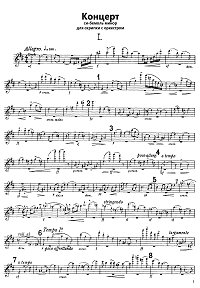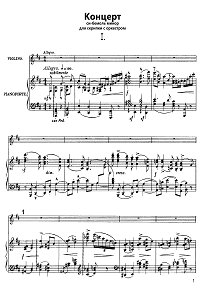Elgar - Violin concerto b-moll Op.61
Elgar - Violin concerto b-moll Op.61. You can download the PDF sheet music Elgar - Violin concerto b-moll Op.61 on this page. Elgar's only concerto for the violin, his own instrument, was completed and first performed in 1910, between the First and Second Symphonies. The score is headed with a dedication to Fritz Kreisler, who was the work's first interpreter, and the first in a long line of distinguished international violinists in whose repertoires it has found a place. The Concerto is laid out in a classical three-movement plan and on a grand scale, in the tradition of the Beethoven and Brahms violin concertos. But the classical formal outlines arc blurred by Elgar's many rhapsodic fluctuations of tempo, and by the fact that the music is constructed not out of a small number of separate themes but out of groups of several interrelated motifs, one growing organically out of another, and placed in constantly changing positions.
To download PDF, click the "Download PDF" button below the appropriate sheet music image.
To view the first page of Elgar - Violin concerto b-moll Op.61 click the music sheet image.
|
| PDF format sheet music |
|
|
|
Instrument part: 24 pages. 1653 K
|
Piano part: 58 pages. 3430 K
|
 |
 |
|
|
| Download PDF (14.99
€) |
Download PDF (14.99
€) |
|
In the first movement, for example, even the very first idea takes a different turn, and assumes a different character, with the dark-coloured first entry of the solo violin. Similarly, a subsidiary idea in the orchestral exposition, a rising figure with a characteristic upward turn, is metamorphosed in the second, solo exposition into a full-length second subject, simply and sweetly sung, without the turn: the relationship between the two is not revealed until they are placed side by side in the very free recapitulation. The seemingly artless opening melody of the Andante, in the remote key of B flat major, suggests that this movement is to have a more straightforward, song-like form. But with the introduction of a more restless and unstable second subject, Elgar's unique brand of organic, closely-worked rhapsody takes over once more, leading the central development section to a climax marked with Elgar's favourite direction of nobilmente.
The finale is formally the least conventional of the three movements, consisting of a statement and varied restatement of a sequence of themes, a transition leading to the work's only cadenza, and a coda. The opening section offers the soloist his greatest opportunities in the piece for high-powered virtuosity of the traditional kind. But all his and the orchestra's activity turns out to be in the nature of a prelude to the long cadenza, which lies at the heart of the movement and indeed of the whole work. Here, against a subdued orchestral background including the 'thrummed' pizzicato tremolando which Elgar invented, the soloist muses nostalgically on themes from the first movement, eventually retracing his steps to his very first entry. With the orchestra, both here and in the passages before and after the cadenza, adding a further reference back to a theme from the second movement, the overall effect, is of a weaving together of all the strands of this rich masterpiece. |
|